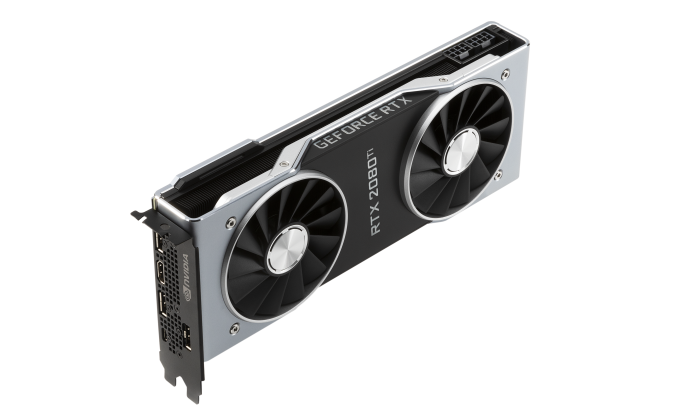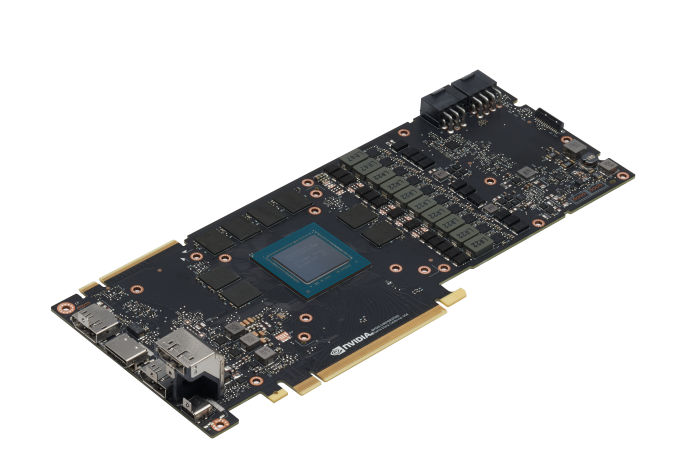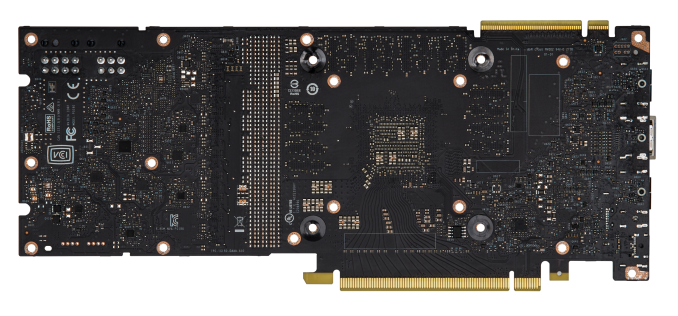The NVIDIA GeForce RTX 2080 Ti & RTX 2080 Founders Edition Review: Foundations For A Ray Traced Future
by Nate Oh on September 19, 2018 5:15 PM EST- Posted in
- GPUs
- Raytrace
- GeForce
- NVIDIA
- DirectX Raytracing
- Turing
- GeForce RTX
Meet The GeForce RTX 2080 Ti & RTX 2080 Founders Editions Cards
Moving onto the design of the cards, we've already mentioned the biggest change: a new open air cooler design. Along with the Founders Edition specification changes, the cards might be considered 'reference' in that they remain a first-party video card sold direct by NVIDIA, but strictly-speaking they are not because they no longer carry reference specifications.
Otherwise, NVIDIA's industrial design language prevails, and the RTX cards bring a sleek flattened aesthetic over the polygonal shroud of the 10 series. The silver shroud now encapsulates an integrated backplate, and in keeping with the presentation, the NVLink SLI connectors have a removable cover.
Internally, the dual 13-blade fans accompany a full-length vapor chamber and component baseplate, connected to a dual-slot aluminum finstack. Looking at improving efficiency and granular power control, the 260W RTX 2080 Ti Founders Edition features a 13-phase iMON DrMOS power subsystem with a dedicated 3-phase system for the 14 Gbps GDDR6, while the 225W RTX 2080 Founders Edition weighing in with 8-phases main and 2-phases memory.
As is typical with higher quality designs, NVIDIA is pushing overclocking, and for one that means a dual 8-pin PCIe power configuration for the 2080 Ti; on paper, this puts the maximum draw at 375W, though specifications-wise the TDP of the 2080 Ti Founders Edition against the 1080 Ti Founders Edition is only 10W higher. The RTX 2080 Founders Edition has the more drastic jump, however, with 8+6 pins and a 45W increase over the 1080's lone 8 pin and 180W TDP. Ultimately, it's a steady increase from the power-sipping GTX 980's 165W.
One of the more understated changes comes with the display outputs, which thanks to Turing's new display controller now features DisplayPort 1.4 and DSC support, the latter of which is part of the DP1.4 spec. The eye-catching addition is the VR-centric USB-C VirtualLink port, which also carries an associated 30W not included in the overall TDP.
Something to note is that this change in reference design, combined with the seemingly inherent low-volume nature of the Turing GPUs, cuts into an often overlooked but highly important aspect of GPU sales: big OEMs in the desktop and mobile space. Boutique system integrators will happily incorporate the pricier higher-end parts but from the OEM’s perspective, the GeForce RTX cards are not just priced into a new range beyond existing ones but also bringing higher TDPs and no longer equipped with blower-style coolers in its ‘reference’ implementation.
Given that OEMs often rely on the video card being fully self-exhausting because of a blower, it would certainly preclude a lot of drop-in replacements or upgrades – at least not without further testing. It would be hard to slot into the standard OEM product cycle at the necessary prices, not to mention the added difficulty in marketing. In that respect, there is definitely more to the GeForce RTX 20 series story, and it’s somewhat hard to see OEMs offering GeForce RTX cards. Or even the RT Cores themselves existing below the RTX 2070, just on basis of the raw performance needed for real time ray tracing effects at reasonable resolutions and playable framerates. So it will be very interesting to see how the rest of NVIDIA’s product stack unfolds.
















337 Comments
View All Comments
Spunjji - Friday, September 21, 2018 - link
If that were true then Nvidia could have left off the RTX parts this time around and created a GPU that offers a simple ~30% performance improvement at roughly the same retail cost.Following that, the die-area benefits from 7nm could have been spent on both RTX features and another ~30% performance boost at a similar or slightly-higher cost. By then they could probably have added enough resources to at least manage high refresh rates at 1080p, if not 2.5K
Instead they massively inflated their die for features that require you to accept resolutions and frame-rates that PC gaming left behind 6 years ago.
mapesdhs - Wednesday, September 26, 2018 - link
That last sentence is something I which tech sites would emphasise a lot more. It very much defines how those who normally buy into the higher tier tech now regard what they like doing and why. NVIDIA pushed hard to create the market for high-refresh gaming, 4K & VR, now suddenly they're trying to do an about-face. I can't see how it can work. I just bought a 27" 1440p IPS panel for 200 UKP, the cost of good screens has come down a lot, and now NVIDIA wants us to drop back down to 1080p? :D I get the impression the reaction of a great many is just laughter.Gastec - Thursday, September 27, 2018 - link
Ahaa! You are getting close :) Come on, just spell it: they want to "milk" us as much as possible before Moore's Law ends and we will completely stop upgrading our PC's and we'll just replace the defective part twice in a life time. No more billions of moneyz for Corporate Commander :)Yojimbo - Wednesday, September 19, 2018 - link
"Please, let's boycott Turing cards."Throw down your chains and resist!
Ranger1065 - Thursday, September 20, 2018 - link
100%Xex360 - Wednesday, September 19, 2018 - link
These cards are a disappointment for the price, the 2080ti should be priced at most 800$, it just doesn't offer the performance required for justifying its price, worse here they compared it to the 1080ti FE which as GamerNexus pointed out is not ideal, for the cards are noticeably slower than other cards with proper cooling, so the 1080ti is at least as fast as the 2080.On the ray tracing side, I like the technology but it's not impressive enough to justify the hefty price tag, I'd rather have a real generational leap with a 2070 beating a 1080ti and a 2080ti having at least 70% more performance than having RT, it's a niche product and obly few games will benefit from it, and the whole DLSS isn't good either limited to only a few games, with more brut force we could achieve 4k and super sampling.
kron123456789 - Wednesday, September 19, 2018 - link
"I'd rather have a real generational leap with a 2070 beating a 1080ti and a 2080ti having at least 70% more performance than having RT"That reminded me of a very old quote:
"If I had asked people what they wanted, they would have said ‘faster horses.’" — Henry Ford
saikrishnav - Wednesday, September 19, 2018 - link
That quote only makes sense if Nvidia came up with a "different" radical product than a graphical horse. They just made a slightly faster horse with a RTX ON button which nobody is ready to push yet i.e. developers. So, if you have a choice between a much faster horse and a RTX ON button - one would take a much faster horse. Now, when developers are ready to push the button/envelope, and sign on to the RTX, then this quote makes sense. Nvidia is asking customers to pay the price of new tech-adoption without show-casing the products that use it. They could have invested with devs and in games, to use the RTX, and then released it. But no, they want to fill in a gap until 7nm arrives.Yojimbo - Wednesday, September 19, 2018 - link
Nobody was ready to push the mass produced automobile button, yet, either. Do you think Ford started mass producing cars and then immediately there were roads and gas stations? No, at first horses could comfortably go many more places than cars could.His quote is entirely appropriate.
There is no gap to fill before 7 nm arrives since AMD will have no competition. NVIDIA introduced this now because they see value in the product which will generate sales. Plus it will get the ball rolling on developers implementing the new technologies that are present in the architecture and will be present in future NVIDIA architectures.
BurntMyBacon - Thursday, September 20, 2018 - link
Have to agree here. No only where automobiles extremely limited in where they could go on introduction, they were also very loud and considered disruptive to society with a large voice of opposition. These new cards at least have the benefit of being able to go anywhere their predecessors can while still enabling new capabilities.I very much agree that nVidia is using this architecture to "get the ball rolling" on the new tech. They are probably very much aware that sales of RTX cards will be lower until they can fit a meaningful amount of the new hardware resources into a mainstream chip. Though, given the size of the chips and typical associated yields, nVidia may still end up selling every chip they can make.